The Samsung Galaxy S6 and S6 edge Review
by Joshua Ho on April 17, 2015 9:00 AM EST- Posted in
- Smartphones
- Samsung
- Mobile
- Galaxy S6
- Galaxy S6 Edge
System Performance
In order to test the Exynos 7420 and the phone in general, we turn to our suite of benchmarks which are able to show how the device performs in common general computing workloads. Something as simple as web browsing is still surprisingly intensive on mobile phones, and in general Android can often be quite stressful to run in the constraints of a ~3W total TDP especially on any phone still running Dalvik due to its strong reliance on bytecode and a virtual machine that translates bytecode to machine code just before and during application runtime. ART improves this significantly, but is limited in the nature of optimization as AOT compilation optimizations are limited by the CPU power of the SoC and the need to compile the application in a reasonable amount of time.
As always, we'll start things off with our browser benchmarks. After getting to use the phone, it became clear to me that Chrome is poorly optimized against the Galaxy S6 as Samsung’s browser is clearly superior in performance. For that reason I've gone ahead and run our benchmarks on both Chrome and on the stock browser, as seen below.

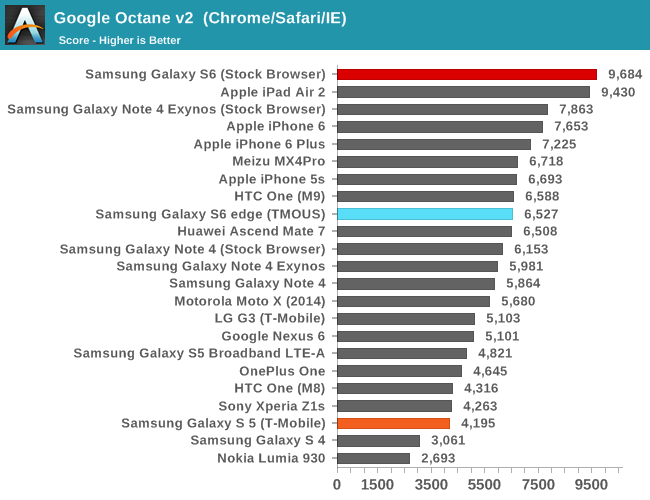

Needless to say, in order to see the full potential of the Exynos 7420 and its cluster of A57s, it’s necessary to use Samsung’s stock browser. This performance is really quite amazing when compared to Apple’s A8X, which has basically been the gold standard for performance in the mobile space in the context of ARM SoCs.
Moving on, as a part of our updates to the benchmark suite for 2015, we'll take a look at Basemark OS II 2.0, which should give a better picture of CPU performance in addition to overall device performance.
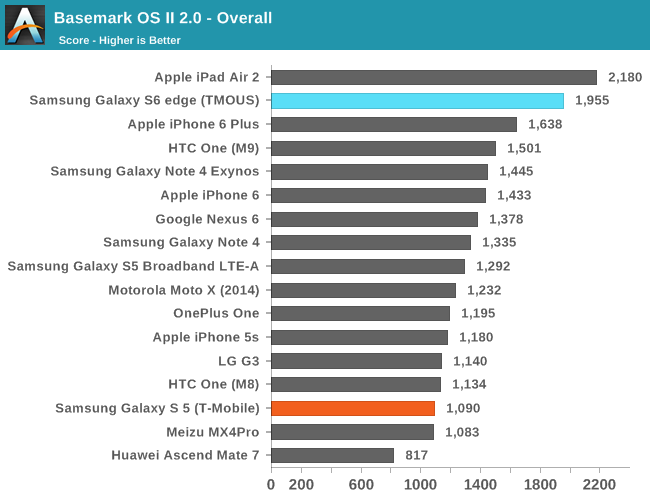
The browser benchmarks seem to hide some pretty enormous variability as the Galaxy S 6 edge (which is comparable to the Galaxy S 6) sets a new record among Android devices. The only challenger is the iPad Air 2, which uses the A8X SoC with three Enhanced Cyclone cores and the semi-custom GXA6850 GPU.
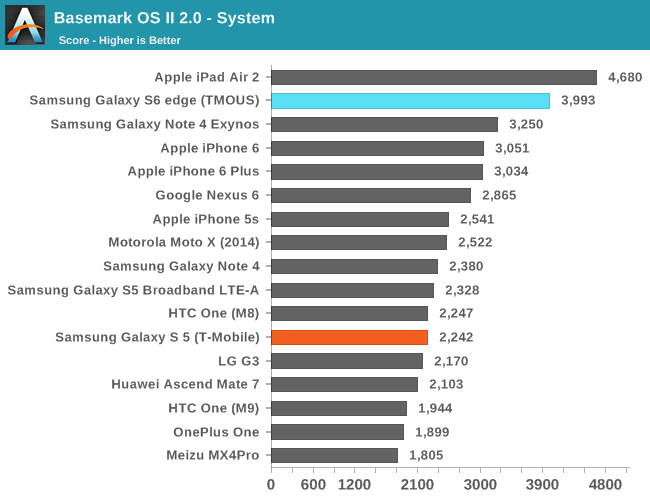
This system test contains a floating point and integer test, in addition XML parsing, which means that this test mostly stresses CPU and RAM. Interestingly enough, the Exynos 7420 pulls far ahead of both the Exynos 5433 and Snapdragon 810 in this test, and approaches the A8X. The difference between the 5433 and 7420 is likely a combination of the higher clocks on both the A57 and A53 clusters for the 7420 (1.9/1.3 on the 5433, 2.1/1.5 on the 7420), in addition to the ability to stay at a high 'overdrive' clock due to reduced leakage from the 14LPE process. The One M9 likely falls a bit short here due to HTC's governor settings restricting the use of all 8 cores simultaneously.

While one might guess that the memory test of 'Basemark OS II 2.0 - Memory' is of RAM, this is actually a test of the internal storage. Once again we see the S6 edge come close to leading the pack due to the use of the new UFS (Universal Flash Storage) standard. Casual examination reveals that the S6 edge has a queue depth of 16, and that it identifies itself with the rather cryptic model name of KLUBG4G1BD-E0B1.
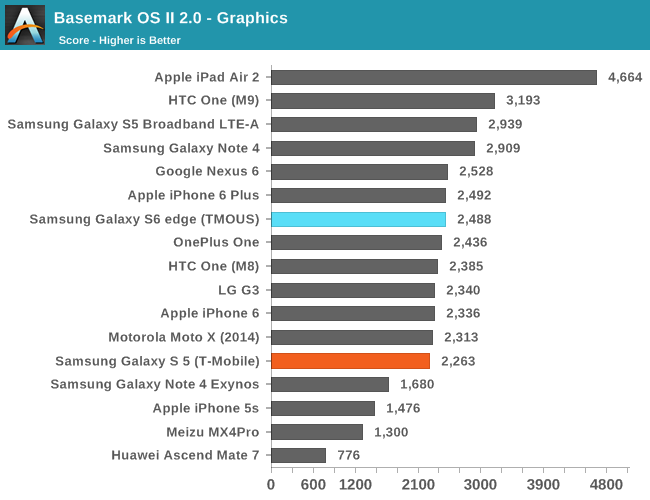
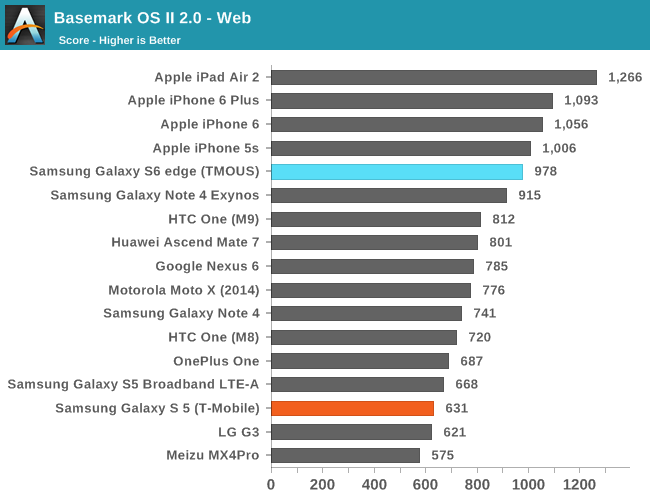
For the web test, it uses the built-in WebView rendering engine rather than Chrome and paints a distinctly different picture, especially because these tests are focused on HTML5 and CSS rather than JavaScript. Here we can see that the iPhone 6 and iPad Air 2 continue to hold their lead, but the Galaxy S6 is pretty much the king of the hill when it comes to Android devices.
Our next system benchmark is PCMark, which does a number of basic benchmarks designed to stress various aspects of the device in everyday workloads like video playback, web browsing, text editing, and photo editing. This tends to test every aspect of a mobile device, unlike microbenchmarks that can often miss aspects of the system that can affect performance.
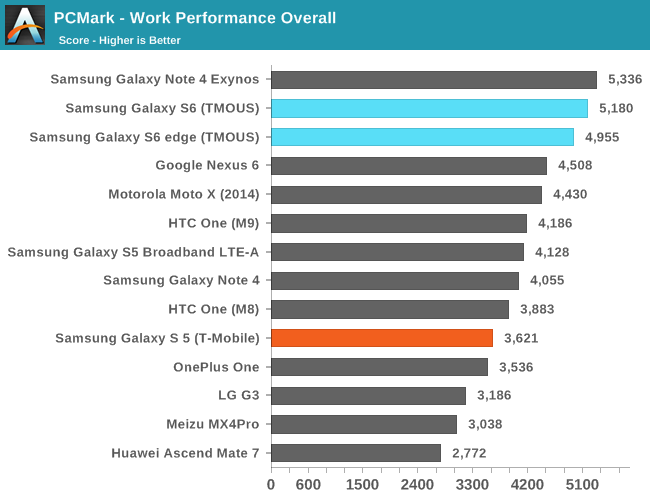
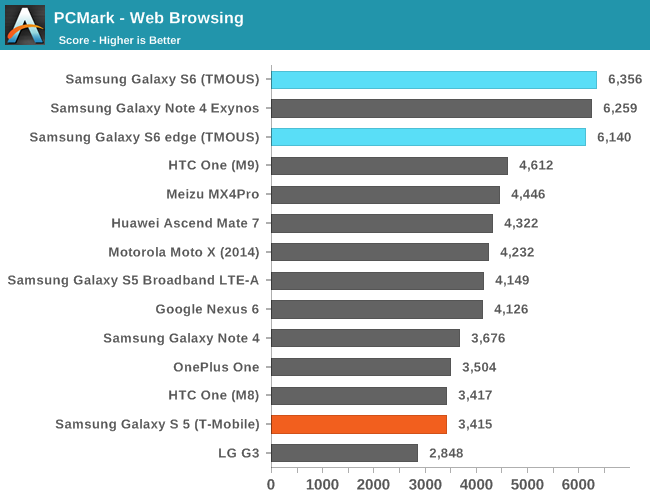
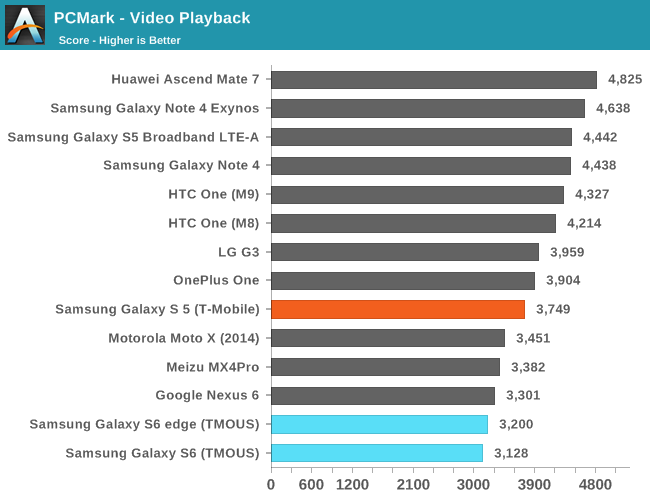
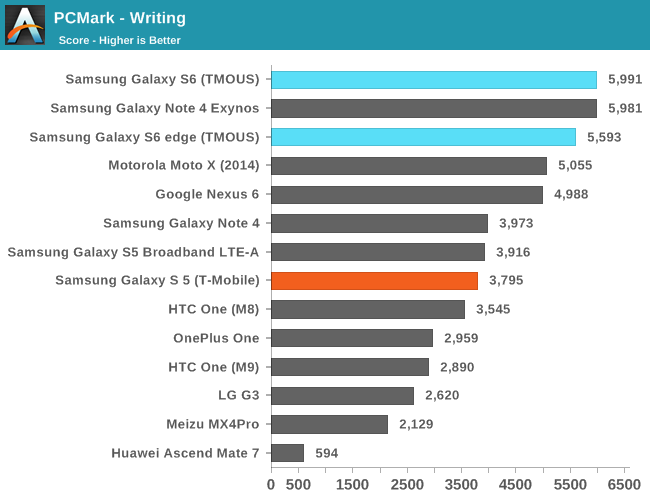

In these tests, the Galaxy S6 continues to perform strongly here due to the fast NAND storage solution and the Exynos 7420 SoC. As we have already covered the Basemark OS II 2.0 results in previous articles, I would refer back to it as those scores are final and have already been contextualized.
Overall, in these general purpose computing tasks that stress CPU, memory, and NAND performance we can see that the Exynos 7420 is off to a flying start. Samsung Mobile should focus more strongly on optimizing the software stack against Chrome as mobile Chrome has around twice the user share of stock Android browsers. I often say that the SoC is the foundation to a good smartphone, and in the case of the Galaxy S6 it feels like this is especially true.










306 Comments
View All Comments
bogda - Saturday, April 18, 2015 - link
External SD on Android is mostly for media files so for me capacity is much more important than performance. Songs and videos will play the same regardless of SD speed.I am not going to watch video at 8x speed.Notmyusualid - Saturday, April 18, 2015 - link
To be honest, I'm happy you are happy with your purchase.To me, it looks gorgeous, but it seems a tiny step down from my GS5. No micro sd slot, no removable battery, no waterproofing (a big one this), and I notice the GFX Bench had worse battery life too.
That record charge time might persuade me, if I were to lose my GS5 drunk etc. But then a second-hand GS5 is a bargin now.
ethebubbeth - Friday, April 17, 2015 - link
My LG G3 has both removable battery and a microSD slot. Here's hoping they continue to carry the torch since it appears that Samsung has dropped it.Ammaross - Friday, April 17, 2015 - link
We'll find out at the end of the month when they announce the LG G4. I'm waiting to see/hear specs on it (officially) before pulling the trigger with an S6. The loss of the SD slot is a bit painful when you have to pony up an extra $100 for a measly extra 32GB....akdj - Friday, April 24, 2015 - link
Or two hundred for incredibly fast internal NAND storage, a bump of 96GB.I've owned each iteration of the Note (business line) except Note 2. Still have the Xoom. iPhones, same --- our employees carry them and I use the 6+ as my personal phone. I didn't upgrade Note 1 --> 2, as I couldn't get out of Note 1 quickly enough (contract). Slow as molasses. 2 changed that, and when it was time to get rid of it, the Note 3 was entirely new 'experience-wise' in comparison. Ten times quicker! I've had the Note 4 since release and I've found the further we move up in Android versions, the less 'control' I've had over where and what storage I'm able to keep on the microSD card
Media, for sure....but for two bills more, over two years is $8/month for 128 GB. I've got the 6+/128 and I've never felt pinched. Even with 3 & 4GB HD movie files I've not compressed. Battery life is incredible on both and other than extended oversea flights I've never had a problem. I also have a TB or 4 at home sharable to the remote phones and tabs from the house but I've never needed to re download extra music or motion while on holiday travel. Best to get out and see the scenery than watch our phones.
128 is a large chunk of internal data to hold. And it's 'not' expensive. If you're a DSLR shooter and use CF cards, motion, or proprietary capture (P2, SxS, RED's SSDs, etc.) --- you know how expensive a 'fast' card is. Even the quickest can't hold a candle to the latest Sammy and Apple MLC/TLC storage. Stairway to Heaven is going to sound the same when you get home but the ability to capture the shots you want, motion and speeds or different resolutions keep the internal NAND's speeds, reliability and prices continue to rise (first two), and drop (price) for these sealed, internal storage modules.
As for batteries ...I've also owned each iPhone and other than Mophie cases on the smaller phones, I've found no such need on the 6+, from the scores shown here...that'll be the case with the S6 as well.
Peichen - Saturday, April 18, 2015 - link
Seems like LG G4 will have removable back, battery and a microSD slot according to leaks.Lonyo - Friday, April 17, 2015 - link
They lost me. My new phone (replacing an S3) arrived yesterday. It has a MicroSD slot and a removable battery.I'm using a MicroSD card in it. It's the one I had in my S3.
Samsung want me to pay $200 premium to upgrade from 32GB to 128GB when I already own 128GB of phone-compatible storage. They can shove it.
Notmyusualid - Saturday, April 18, 2015 - link
+1juxt417 - Wednesday, April 22, 2015 - link
Hope you have everything backed up for if/when that bad boy fails. I gave up on SD cards after mine burnt out.ahw - Friday, April 17, 2015 - link
SD Card slot is the bigger issue, IMO. Samsung has already lost a customer: me. I have an S4 and am eligible for an upgrade. It won't be the S6.